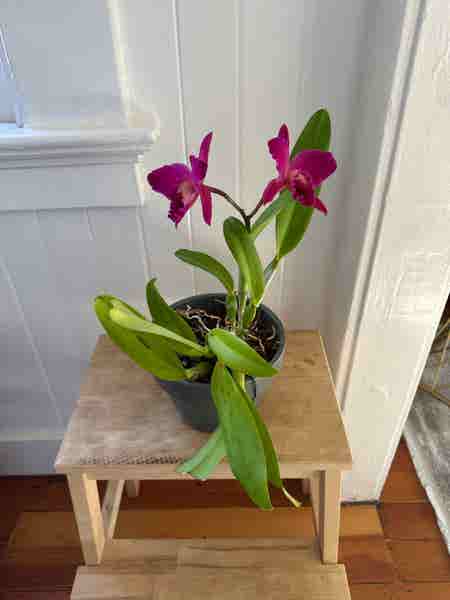





































Crimson Cattleya
About Crimson Cattleya
Crimson Cattleya is a relatively rare houseplant 🌿 that needs regular watering to thrive. They do best in abundant sunlight ☀ and should be less than 3 feet from a window.
Crimson Cattleya likes soil that is well draining.
Crimson Cattleya belongs to the Cattleya genus, and is native to Brazil.
Taxonomy

Cattleya labiata
Cattleya
Orchidaceae
Asparagales
Also known as
Ruby-lipped Cattleya and Cattleya lab

How to care for Crimson Cattleya
How often to water your Crimson Cattleya

every 9
Crimson Cattleya needs 0.5 cups of water every 9 when it doesn’t get direct sunlight and is potted in a 5" pot.
Use our water calculator to personalize watering recommendations to your environment or download Greg for more advanced recommendations for all of your plants.

Water 0.5 cups every
9
Finding light for Crimson Cattleya in your home

a window
Crimson Cattleya may have difficulty thriving, and will drop leaves 🍃, without ample sunlight.
Place it less than 3 feet from a south-facing window to maximize the potential for growth.
Select your region to see how the current weather in your area affects the placement of Crimson Cattleya in your home 🏡.
How to fertilize Crimson Cattleya

Most potting soils come with ample nutrients which plants use to produce new growth.
By the time your plant has depleted the nutrients in its soil it’s likely grown enough to need a larger pot anyway.
To replenish this plant's nutrients, repot your Crimson Cattleya after it doubles in size or once a year—whichever comes first.
Care Summary for Crimson Cattleya

Crimson Cattleya
 Greg recommends:
Greg recommends:
 Water
Water
0.5 cups every 9 days
 Placement
Placement
< 3ft from a window
 Nutrients
Nutrients
Repot after 2x growth
Based on the 4” pot your plant is in, and that it doesn’t get direct sunlight.

 Trending in your area
Trending in your area
 Similar to Crimson Cattleya
Similar to Crimson Cattleya
✨ Discover rare plants

Sedeveria 'Blue Elf'

Joan Daniel Echeveria

Philodendron 'Silver …

Euphorbia Ammak

Parrot Pitcher Plant

Aloe 'Lavender Star'

Scindapsus pictus 'Si…

Orange Lipstick Plant

Cereus peruvianus 'Pa…

Royal Flush Split Rock

Hoya kalimantan

Echeveria Arrow

Raphionacme flanaganii

Begonia lubbersii

Black Monkey Thorn Tr…

Peperomia 'Harmony's …

Stanhopea tigrina




























